Assessment of Ecological Assets for Sustainable Regional Development: A Case Study of Deqing County, China
Abstract
:1. Introduction
2. Material and Methods
2.1. Study Area
2.2. Data Sets
2.3. County-Level Indicators for Valuation of Ecological Assets
2.4. The valuation of Produced Organic Material
2.5. The Valuation of Releasing Oxygen and Storing Carbon
2.6. The Valuation of Water Conservation
2.7. The Valuation of Air Purification
2.8. The Valuation of Nutrients Accumulation
2.9. The Valuation of Soil Conservation
2.10. The Valuation of Natural Resources
2.11. Assessment of Regional Sustainable Development at County Level
3. Results
3.1. The Valuation of Produced Organic Material of Ecosystems
3.2. The Valuation of Air Purification and Oxygen Releasing
3.3. The Valuation of Water Conservation
3.4. Soil Conservation and Nutrients Accumulation
3.5. The valuation of Natural Resources
3.6. The Valuation of Ecosystem Services
3.7. The Valuation of Ecological Assets
3.8. Measurement of Political Performance at Township Level
4. Conclusions
Acknowledgments
Author Contributions
Conflicts of Interest
References
- Liu, H.; Zhou, G.; Wennersten, R.; Frostell, B. Analysis of sustainable urban development approaches in China. Habitat Int. 2014, 41, 24–32. [Google Scholar] [CrossRef]
- National Bureau of Statistics of China (NBSC). China Statistical Yearbook; China Statistics Press: Beijing, China, 2011.
- Gao, J.; Tian, M. Analysis of over-consumption of natural resources and the ecological trade deficit in China based on ecological footprints. Ecol. Ind. 2016, 61, 899–904. [Google Scholar] [CrossRef]
- Wang, C.; Pan, D. Zoning of Hangzhou Bay ecological red line using GIS-based multi-criteria decision analysis. Ocean Coast. Manag. 2017, 139, 42–50. [Google Scholar]
- Dong, M.; Wu, D.; Fu, X.; Deng, H.; Wu, G. Regional-scale analysis on the strengths, weaknesses, opportunities, and threats in sustainable development of Shangri-La County. Int. J. Sustain. Dev. World 2015, 22, 171–177. [Google Scholar] [CrossRef]
- Zorpas, A.A. Sustainability behind Sustainability; Nova Science Publishers Inc.: New York, NY, USA, 2014. [Google Scholar]
- Ebrahimzadeh, I.; Aghasizadeh, A.A. The analysis of effective factors in the expansion of coastal region of Chabahar tourism through SWOT model. J. Urban Reg. Stud. Res. 2009, 1, 107–128. [Google Scholar]
- Zorpas, A.A.; Voukkali, I.; Pedreño, J.N. Tourist area metabolism and its potential to change through a proposed strategic plan in the framework of sustainable development. J. Clean. Prod. 2017. [Google Scholar] [CrossRef]
- Badri, S.A.; Rahmani, K.; Qeydari, M.S.; Poor, O.H. Strategies of ecotourism development in Marivan township. Rural Res. 2011, 2, 6–10. [Google Scholar]
- Radulescu, C.V. Tourism and environment towards a European tourism policy. J. Knowl. Manag. Econ. Inf. Technol. 2011, 1, 66–76. [Google Scholar]
- Voukkali, I. The impact of tourist sector in the waste management plans. Desalin. Water Treat. 2014, 56, 1–9. [Google Scholar]
- Xie, H.; Yao, G.; Liu, G. Spatial evaluation of the ecological importance based on GIS for environmental management: A case study in Xingguo county of China. Ecol. Indic. 2015, 51, 3–12. [Google Scholar] [CrossRef]
- Ioppolo, G.; Cucurachi, S.; Salomone, R.; Saija, G.; Shi, L. Sustainable local development and environmental governance: A strategic planning experience. Sustainability 2016, 8, 180. [Google Scholar] [CrossRef]
- Yue, W.; Zhang, Y.; Ye, X.; Cheng, Y.; Leipnik, M.R. Dynamics of multi-scale intra-provincial regional inequality in Zhejiang, China. Sustainability 2014, 6, 5763–5784. [Google Scholar] [CrossRef]
- Courtney, P.; Mayfield, L.; Tranter, R.; Jones, P.; Errington, A. Small towns as ‘sub-poles’ in English rural development: Investigating rural–urban linkages using sub-regional social accounting matrices. Geoforum 2007, 38, 1219–1232. [Google Scholar] [CrossRef]
- Singh, R.K.; Murty, H.R.; Gupta, S.K.; Dikshit, A.K. An overview of sustainability assessment methodologies. Ecol. Indic. 2009, 9, 189–212. [Google Scholar] [CrossRef]
- Lin, Z.; Wu, C.; Hong, W. Visualization analysis of ecological assets/values research by knowledge mapping. Acta Ecol. Sin. 2015, 35, 142–154. [Google Scholar] [CrossRef]
- Wang, R.S.; Li, F.; Hu, D.; Larry, L.B. Understanding eco-complexity: Social–economic–natural complex ecosystem approach. Ecol. Complex. 2011, 8, 15–29. [Google Scholar] [CrossRef]
- Yao, G.; Xie, H. Rural spatial restructuring in ecologically fragile mountainous areas of southern China: A case study of Changgang Town, Jiangxi Province. J. Rural Stud. 2016, 47, 435–448. [Google Scholar] [CrossRef]
- Deqing Statistics Bureau (DSB). Statistical Yearbook of Deqing County (2015); China Statistics Press: Beijing, China, 2011.
- Jin, C.; Cheng, J.; Lu, Y.; Huang, Z.; Cao, F. Spatial inequity in access to healthcare facilities at a county level in a developing country: A case study of Deqing County, Zhejiang, China. Int. J. Equity Health 2015, 14, 1–19. [Google Scholar] [CrossRef] [PubMed]
- National Earth System Science Data Sharing Infrastructure. Scientific Data Center of Yangtze River Delta. Available online: http://nnu.geodata.cn:8008/ (accessed on 21 January 2016).
- Fang, Q.; Zhang, L.; Hong, H. Ecological function zoning for environmental planning at different levels. Environ. Dev. Sustain. 2008, 10, 41–49. [Google Scholar] [CrossRef]
- Song, W.; Deng, X.; Yuan, Y.; Wang, Z.; Li, Z. Impacts of land-use change on valued ecosystem service in rapidly urbanized North China Plain. Ecol. Model. 2015, 318, 245–253. [Google Scholar] [CrossRef]
- Ioppolo, G.; Saija, G.; Salomone, R. From coastal management to environmental management: The sustainable eco-tourism program for the mid-western coast of Sardinia (Italy). Land Use Policy 2013, 31, 460–471. [Google Scholar] [CrossRef]
- Wang, H.; Gao, Z.; Li, Z.; Wang, Z.; Bai, L.; Wang, Z. The value assessment of county-level ecological assets: A case in Fengning County, Hebei Province. Acta Ecol. Sin. 2012, 32, 7156–7168. [Google Scholar] [CrossRef]
- Ministry of Agriculture of the People’s Republic of China. Chinese Agricultural Information Network. 2008. Available online: http://www.agri.cn (accessed on 6 March 2016).
- Zhu, W. Estimation of Net Primary Productivity of Chinese Terrestrial Vegetation Based on Remote Sensing and Its Relationship with Global Climate Changes; Beijing Normal University: Beijing, China, 2005; pp. 163–164. [Google Scholar]
- Gao, J. Evaluation of Regional Ecological Assets—Theory, Method and Application; Science Press: Beijing, China, 2013. [Google Scholar]
- Jin, F.; Lu, S.; Yu, X.; Rao, L.; Niu, J.; Xie, Y. Forest ecosystem service and its evaluation in China. Chin. J. Appl. Ecol. 2005, 16, 1531–1536. [Google Scholar]
- Jiang, L.; Tan, Z.; Xie, W. Estimation of grassland ecosystem services value of China using remote sensing data. J. Nat. Resour. 2007, 22, 161–170. [Google Scholar]
- State Forestry Administration of the People’s Republic of China. Specifications for Assessment of Forest Ecosystem Service in China; Standards Press of China: Beijing, China, 2008; pp. 32–33. [Google Scholar]
- Liu, J. Study on the Spatial Change of Boundary and Its Ecological Effect in the Farming-Pastoral Ecotone of Northern China; University of Chinese Academy of Sciences: Beijing, China, 2008; pp. 67–69. [Google Scholar]
- Zhao, T. Research on China Terrestrial Ecosystem Services and Their Valuation; University of Chinese Academy of Sciences: Beijing, China, 2004; pp. 82–84. [Google Scholar]
- Zhou, X. Study on economic evaluation of forest public welfare efficiency in Heilongjiang Province. For. Inv. Des. 1998, 2, 48–51. (In Chinese) [Google Scholar]
- Ma, X. Forest Hydrology; China Forestry Press: Beijing, China, 1993; pp. 123–128. [Google Scholar]
- Yang, H.; Cao, M.; Fan, F. Comparison of comprehensive benefits between alfalfa and corn in agriculture-pasture ecotone in the Northeast China. Chin. J. Eco-Agric. 2005, 13, 107–109. [Google Scholar]
- Li, C. Research of Regional Ecosystem Service Value Evaluation Based on GIS; Zhejiang University: Hangzhou, China, 2010; pp. 1–88. [Google Scholar]
- Zhejiang Environmental Bureau. Announcement for the Provincial-Level Collection of Standards Fees for Pollution Discharge in the 3rd Quarter of 2015. 2015. Available online: http://www.zj.gov.cn/art/2015/10/30/art_5502_2018133.html (accessed on 8 February 2016).
- National Development and Reform Commission of the People’s Republic of China. The Degree No. 31 Charging Standard and Calculation Method of Pollution Discharge Fees. 2003. Available online: http://www.china.com.cn/chinese/huanjing/654865.htm (accessed on 8 February 2016).
- Wang, H.; Wang, B.; Wu, J. Study on the techniques of valuation of ecosystem services based on remote sensing in Anxin County. Proc. SPIE Int. Soc. Opt. Eng. 2014, 9158, 451–467. [Google Scholar]
- Biodiversity Research Group. Research Report on the Biodiversity Situation of China. Beijing; China Environmental Science Press: Beijing, China, 1998; pp. 92–95. [Google Scholar]
- China’s Chemical Fertilizer Website. Available online: www.fert.cn (accessed on 3 December 2015).
- D’Amato, D.; Rekola, M.; Li, N.; Toppinen, A. Monetary valuation of forest ecosystem services in China: A literature review and identification of future research needs. Ecol. Econ. 2016, 121, 75–84. [Google Scholar] [CrossRef]
- The Ministry of Water Resources of the People’s Republic of China. Standard for Classification and Gradation of Soil Erosion; Standards Press of China: Beijing, China, 2008; pp. 14–16. [Google Scholar]
- Cohen, M.J.; Shepherd, K.D.; Walsh, M.G. Empirical reformulation of the Universal Soil Loss Equation for erosion risk assessment in a tropical watershed. Geoderma 2005, 124, 235–252. [Google Scholar] [CrossRef]
- Tao, Y.; Li, F.; Wang, R.S.; Zhao, D. Effects of land use and cover change on terrestrial carbon stocks in urbanized areas: A study from Changzhou, China. J. Clean. Prod. 2015, 103, 651–657. [Google Scholar] [CrossRef]
- Thierfelder, C.; Wall, P.C. Effects of conservation agriculture on soil quality and productivity in contrasting agro-ecological environments of Zimbabwe. Soil Use Manag. 2012, 28, 209–220. [Google Scholar] [CrossRef]
- Field, C.B.; Randerson, J.T.; Malmstron, C.M. Gloval net primary production: Combining ecology and remote sensing. Remote Sens. Environ. 1995, 51, 74–88. [Google Scholar] [CrossRef]
- Chen, X.; Zhang, Q.; Zhou, K.; Sun, L. Quantitative evaluation and dynamic analysis of ecological assets in arid area. Chin. Sci. Bull. 2006, 51, 168–174. [Google Scholar] [CrossRef]
- Ma, L.; Tan, X.; Sun, N.; Yang, G. The pattern of ecological capital in Daxiaoxinganling, Heilongjiang Province, China. Ecol. Sin. 2013, 33, 7838–7854. [Google Scholar]
- Sun, H. Cause of eco-property loss of grassland in China and discussion for renewal construction of new-model. Acta Part. Sin. 2014, 10, 1–5. [Google Scholar]
- Taddeo, R.; Simboli, A.; Ioppolo, G.; Morgante, A. Industrial symbiosis, networking and innovation: The potential role of innovation poles. Sustainability 2017, 9, 169. [Google Scholar] [CrossRef]
- Chertow, M.R.; Ashton, W.S.; Espinosa, J.C. Industrial symbiosis in Puerto Rico: Environmentally related agglomeration economies. Reg. Stud. 2008, 42, 1299–1312. [Google Scholar] [CrossRef]
- Sterr, T.; Ott, T. The industrial region as a promising unit for eco-industrial development reflections, practical experience and establishment of innovative instruments to support industrial ecology. J. Clean. Prod. 2004, 12, 947–965. [Google Scholar] [CrossRef]
- Banzhaf, H.S.; Boyd, J. The Architecture and Measurement of an Ecosystem Services Index. Sustainability 2012, 4, 430–461. [Google Scholar] [CrossRef]
- Lewis, J.M. The politics and consequences of performance measurement. Policy Soc. 2015, 34, 1–12. [Google Scholar] [CrossRef]
- Jing, Y.; Cui, Y.; Li, D. The politics of performance measurement in China. Policy Soc. 2015, 34, 49–61. [Google Scholar] [CrossRef]
- Chan, H.S.; Gao, J. Putting the cart before the horse: Accountability or performance? Aust. J. Public Adm. 2009, 68, S51–S61. [Google Scholar] [CrossRef]
- Li, P.; Lu, Y.; Wang, J. Does flattening government improve economic performance? Evidencefrom China. J. Dev. Econ. 2016, 123, 18–37. [Google Scholar] [CrossRef]
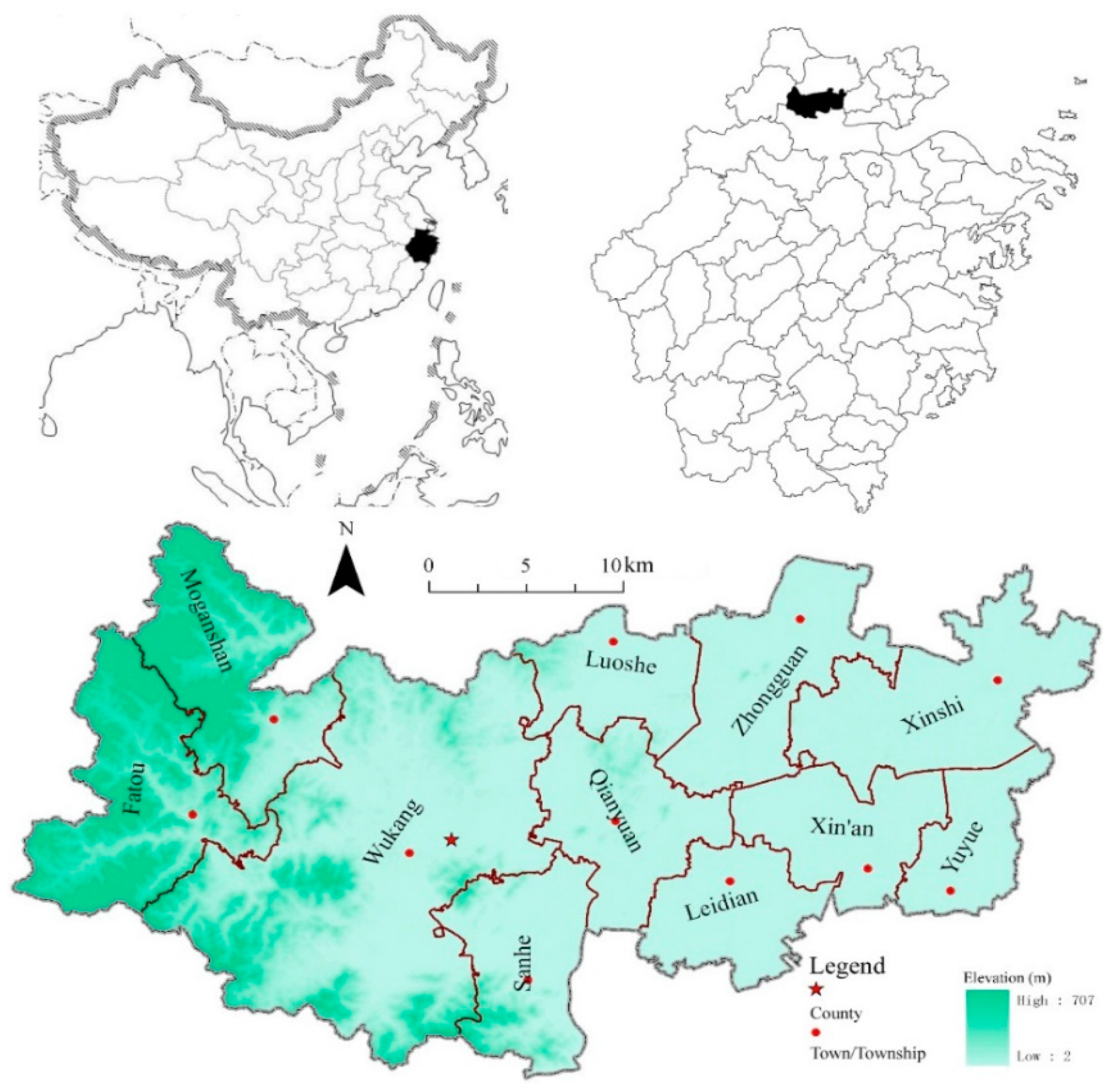
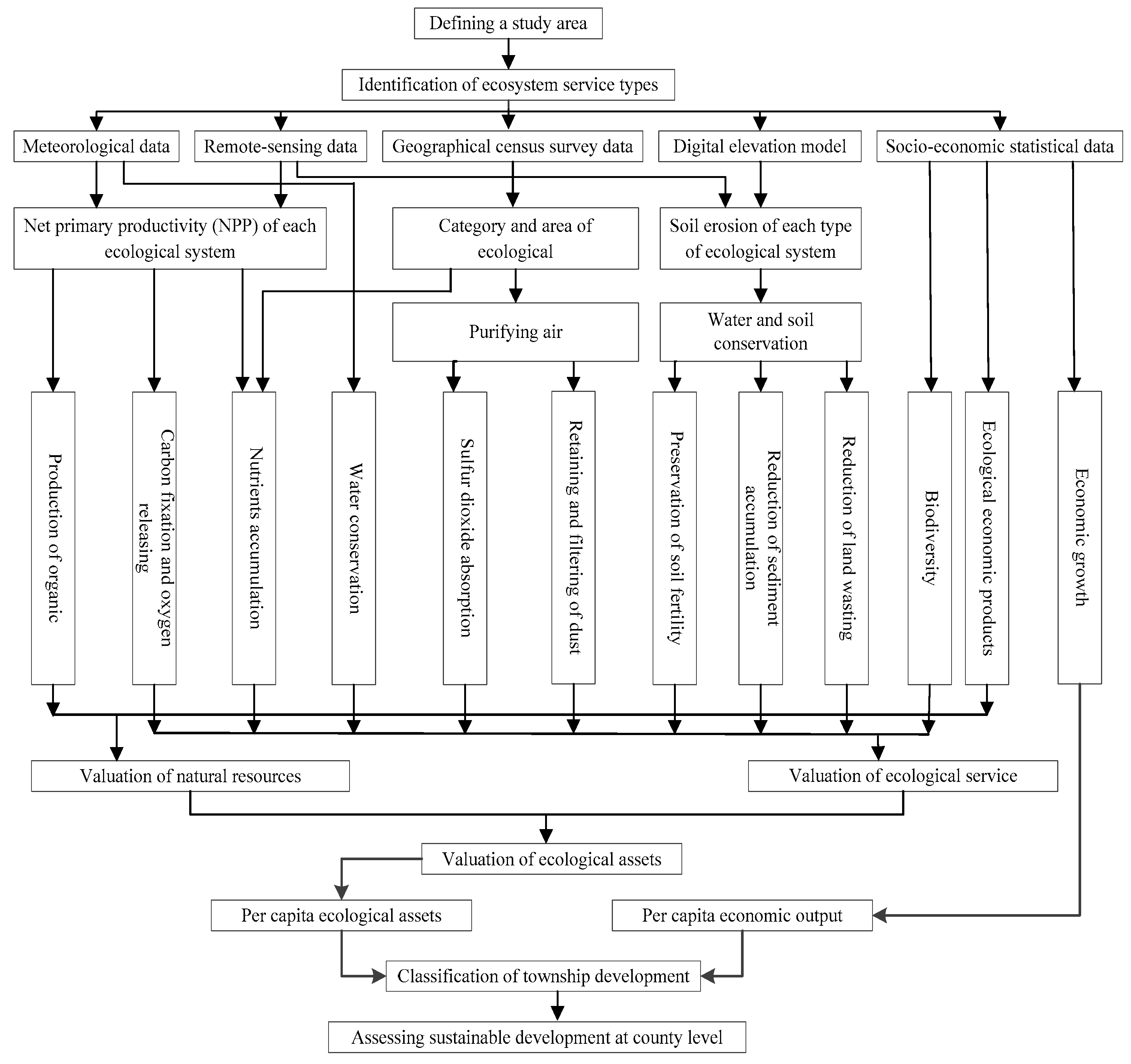


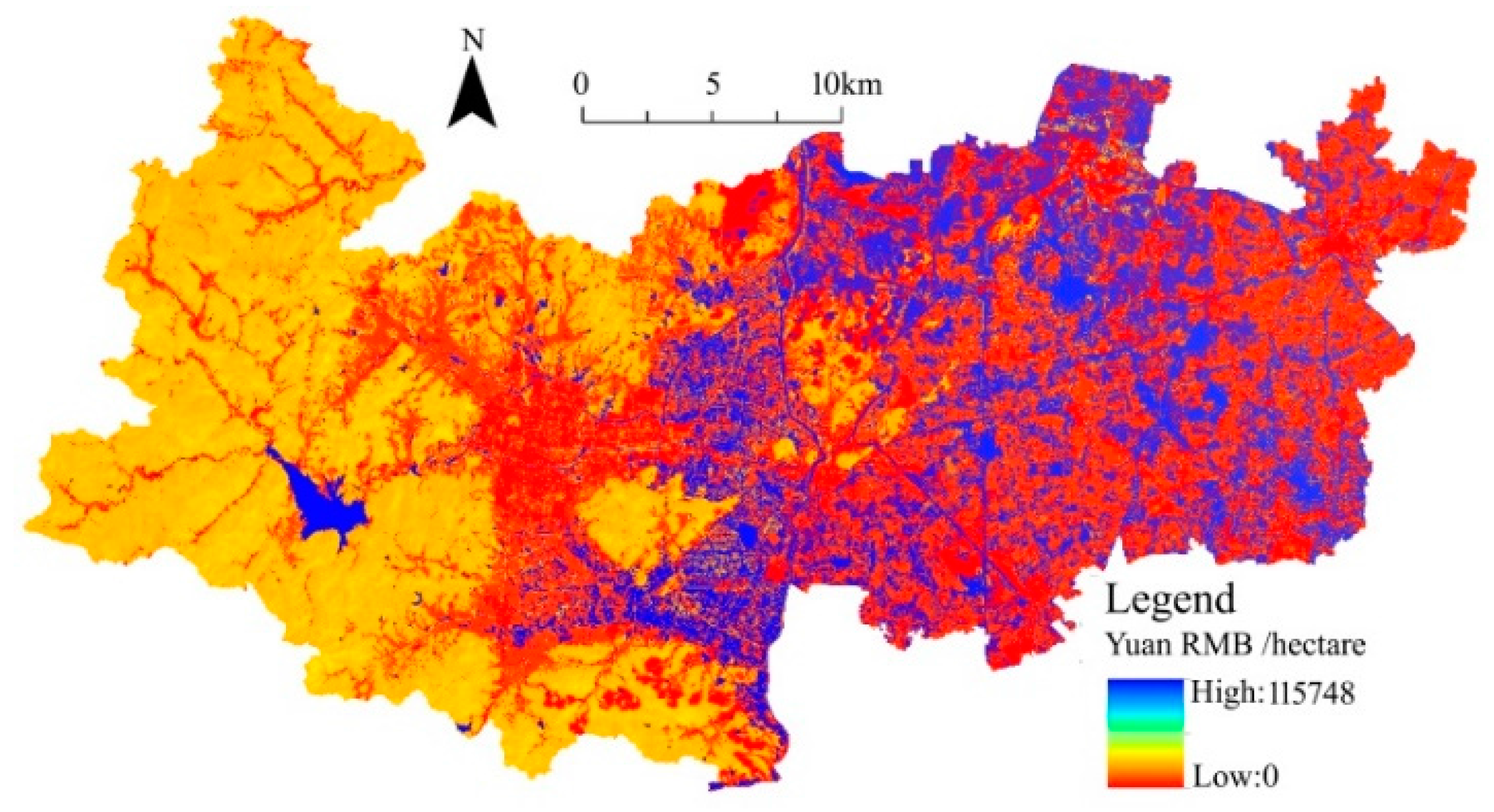

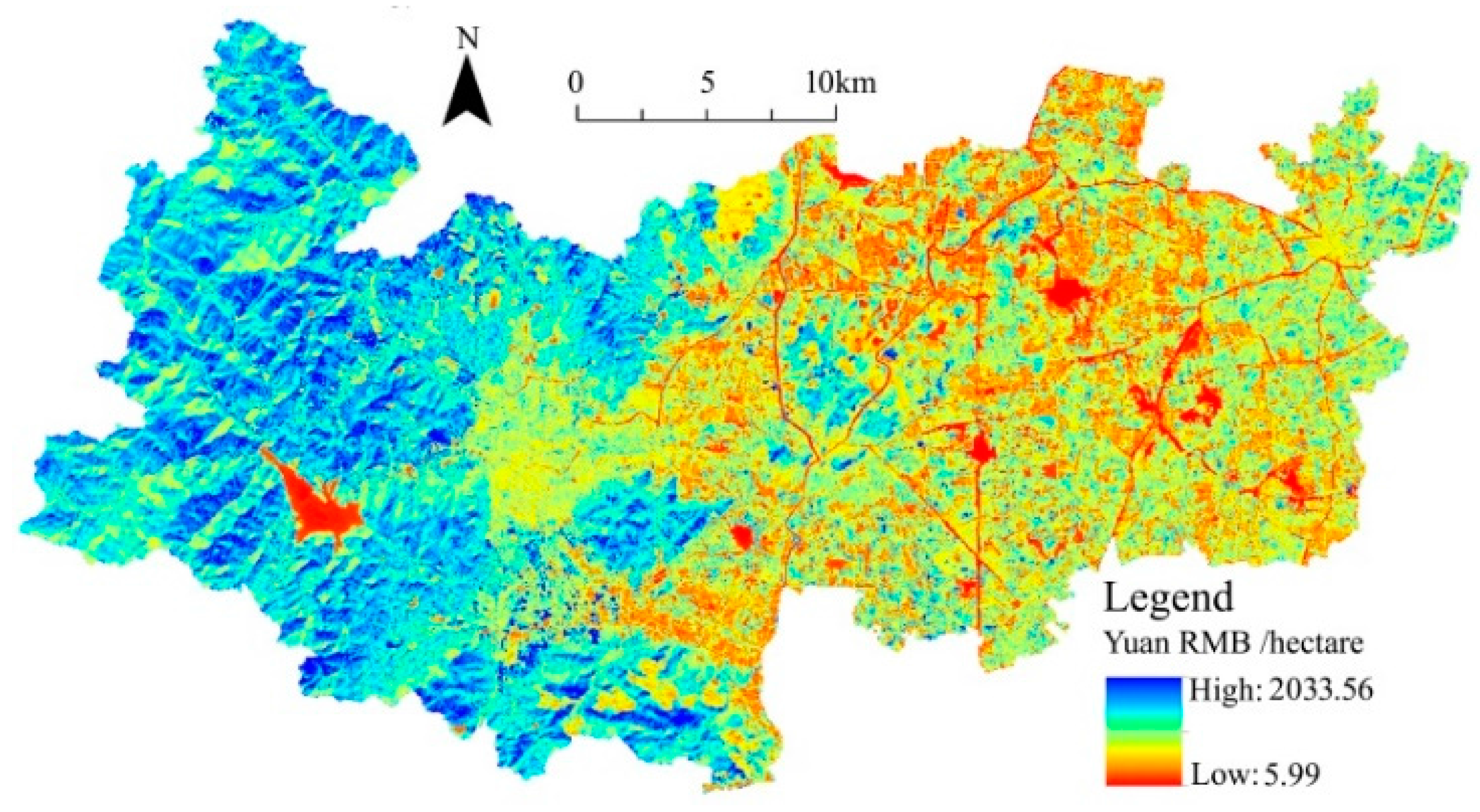
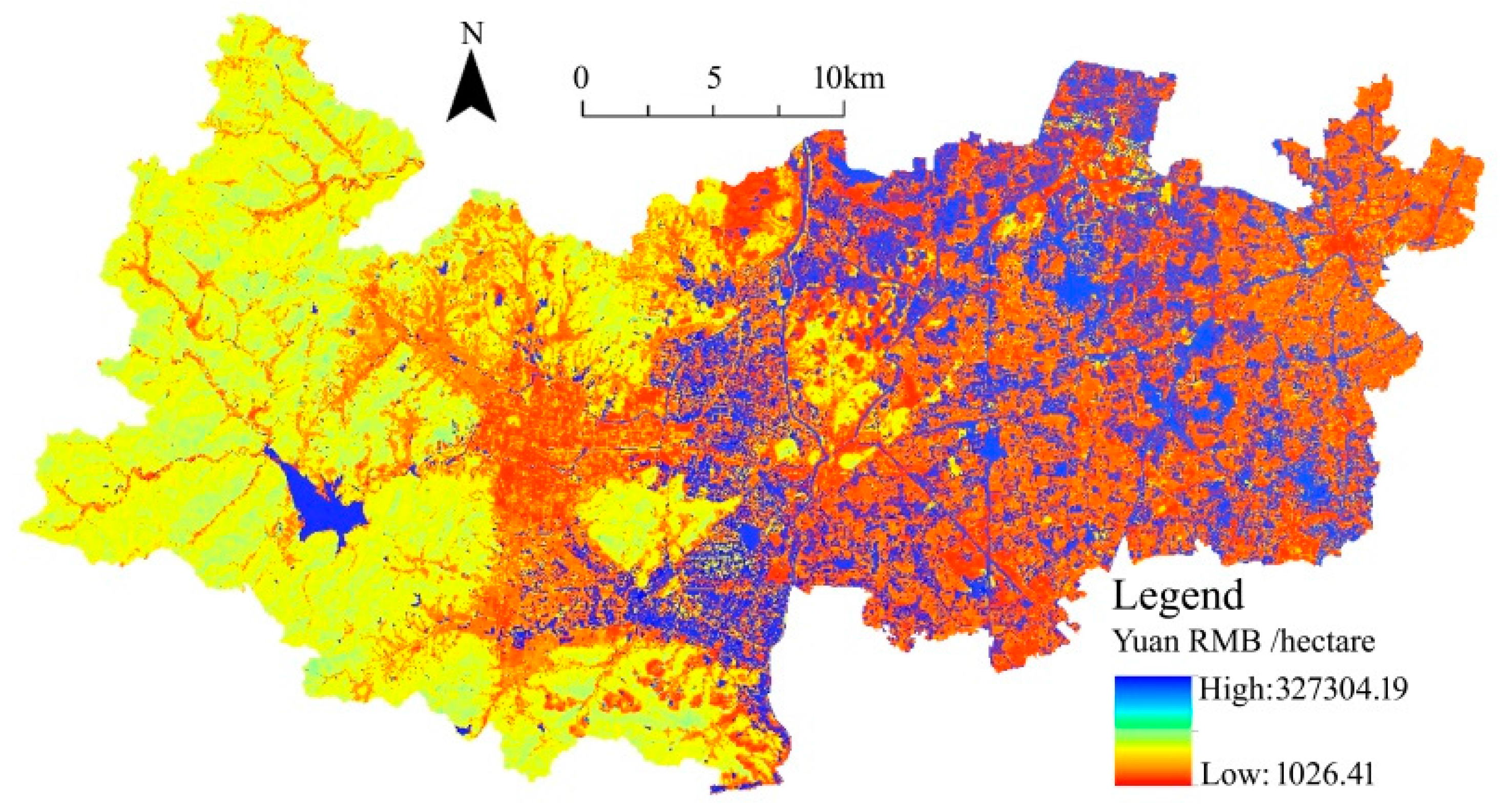
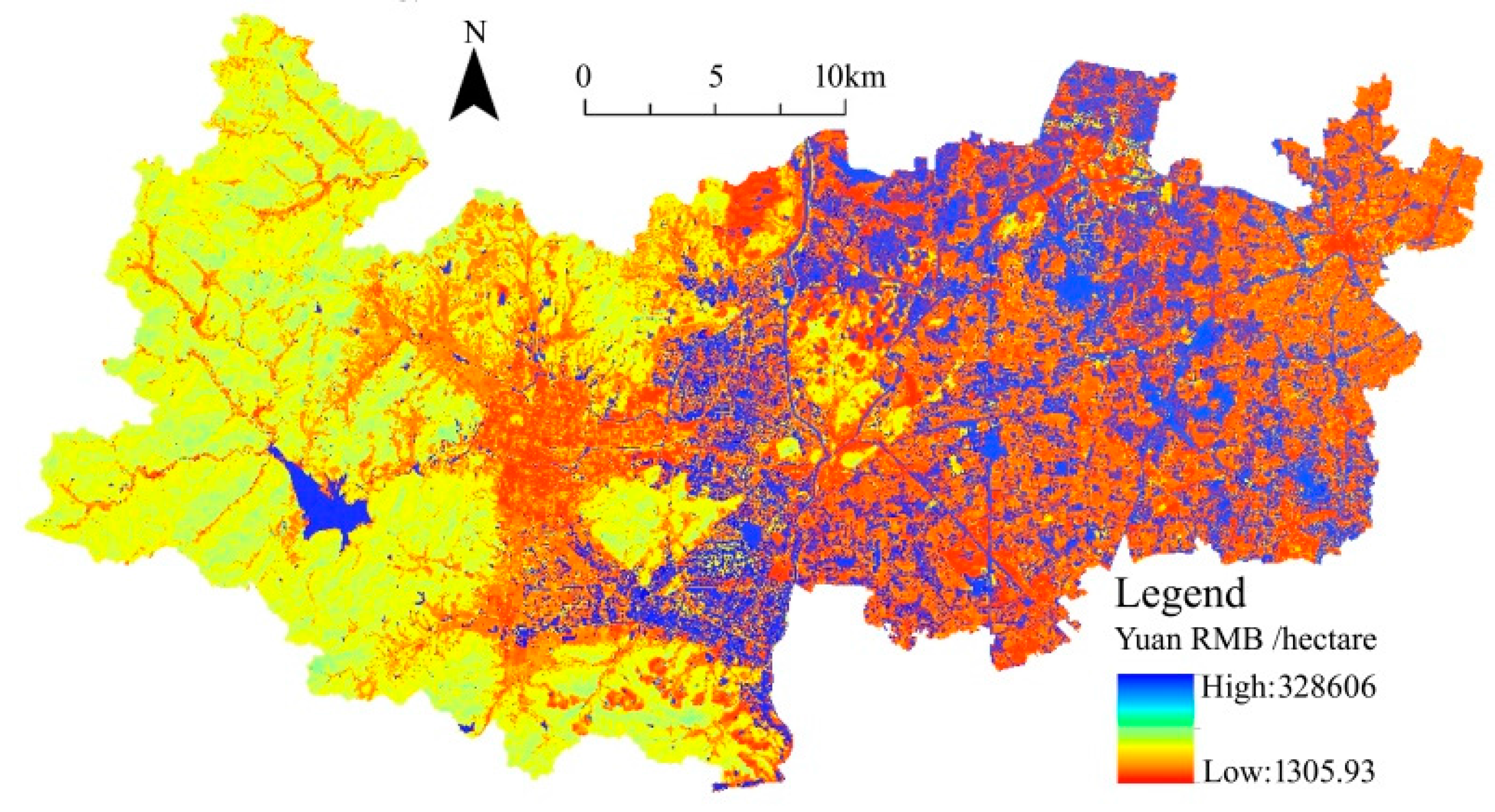
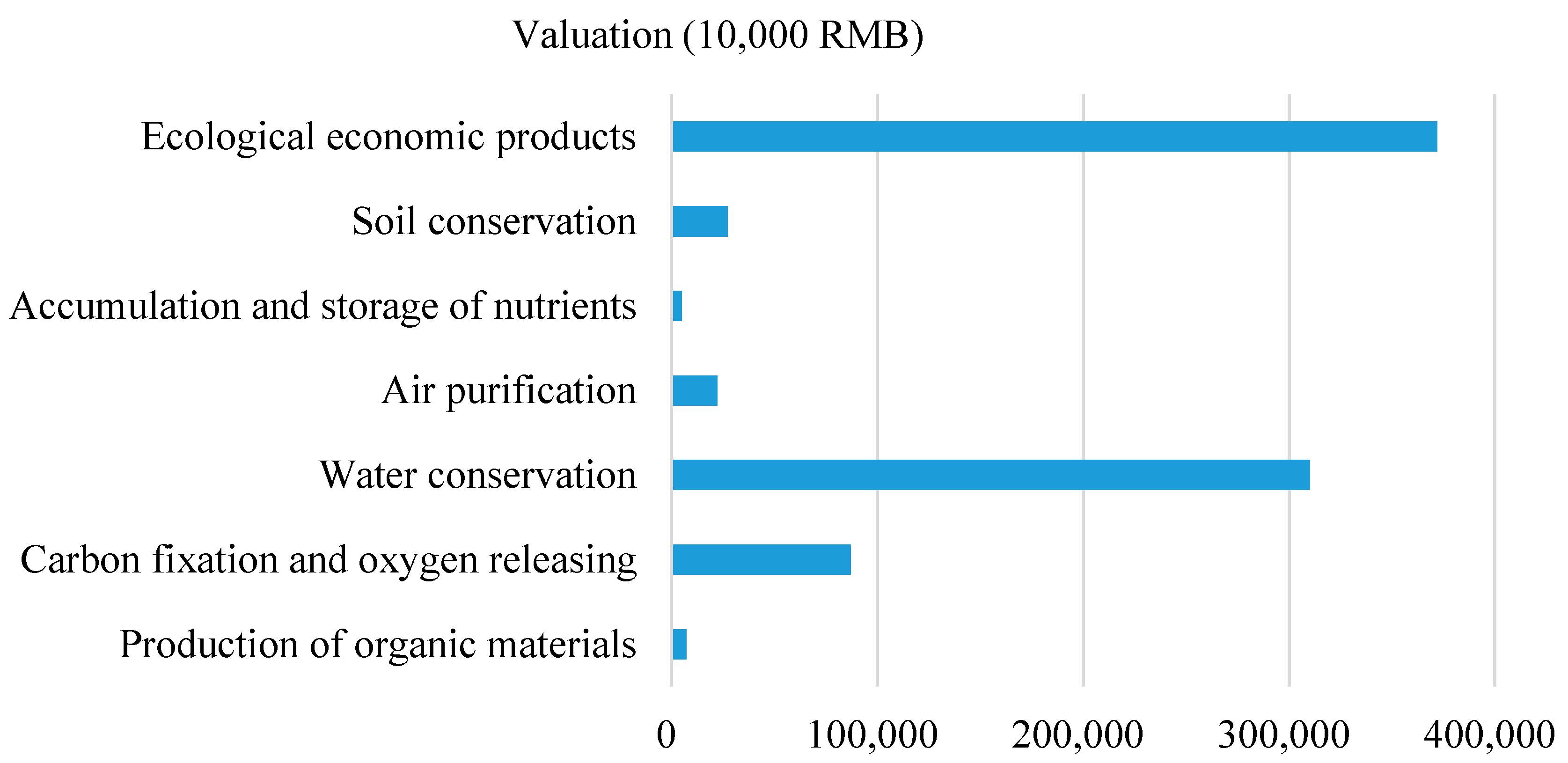
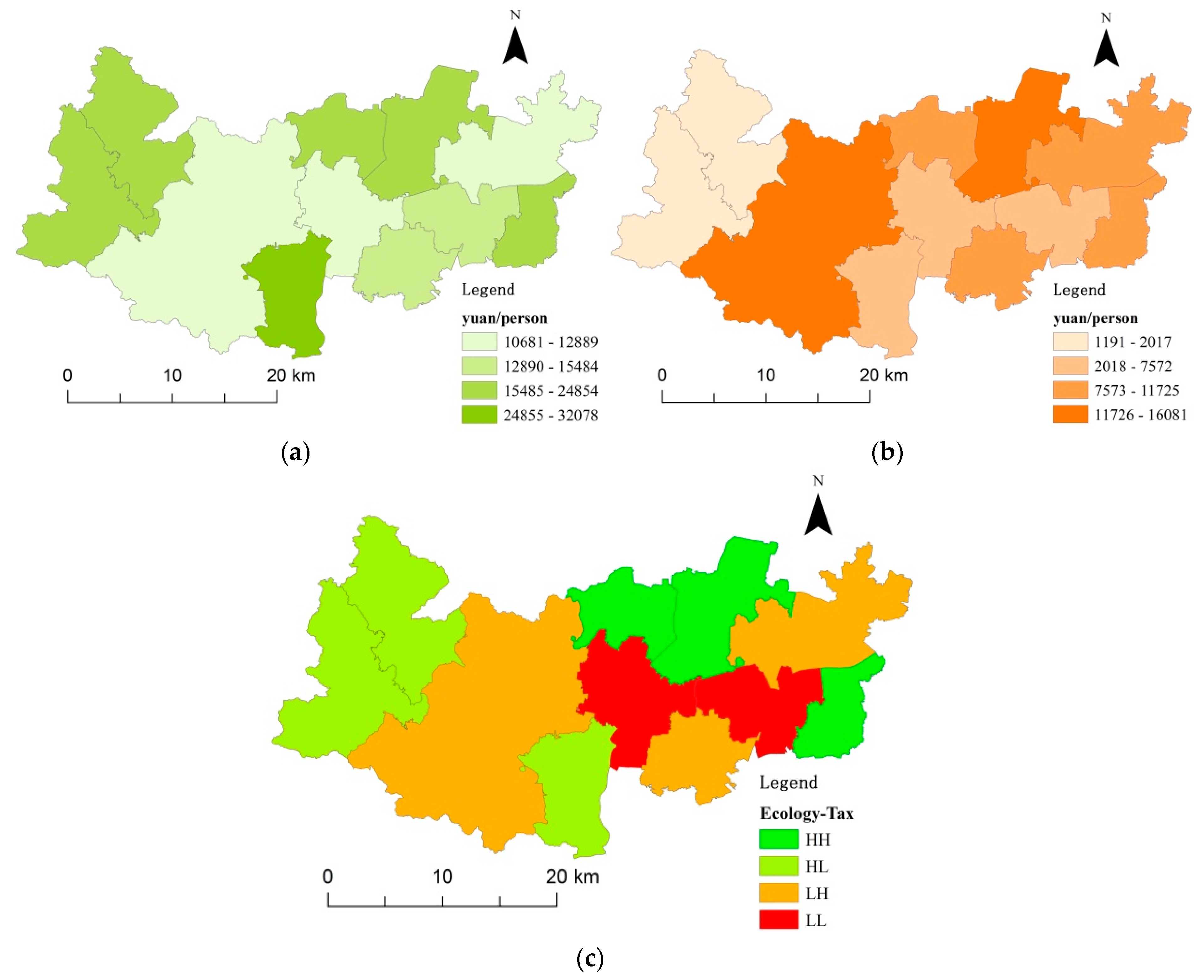
| Indicator | Ecosystem Services | Ecosystem Functions | Physical Quantity |
|---|---|---|---|
| 1 | Storage of solar energy | Production of organic materials | Net Primary Productivity |
| 2 | Gas regulation | Storing carbon and releasing oxygen | Net Primary Productivity |
| 3 | Water regulation | Water conservation | Net Primary Productivity |
| 4 | Environment purification | Air purification | Water conservation |
| 5 | Accumulation of nutrients | Circulation and storage of nutrients | Soil conservation |
| 6 | Preserving soil nutrient, reducing land waste and sediment accumulation | Soil conservation | Volume of air purification |
| Item | Farmland | Garden | Forest | Grassland | Construction Land | Water | Desert |
|---|---|---|---|---|---|---|---|
| N | 0.013288 | 0.013288 | 0.004180 | 0.132890 | 0.013203 | 0.004204 | 0.013273 |
| P | 0.000090 | 0.000090 | 0.000890 | 0.000093 | 0.000087 | 0.000901 | 0.000091 |
| K | 0.008915 | 0.008915 | 0.001810 | 0.008908 | 0.008874 | 0.001820 | 0.008909 |
© 2017 by the authors. Licensee MDPI, Basel, Switzerland. This article is an open access article distributed under the terms and conditions of the Creative Commons Attribution (CC BY) license (http://creativecommons.org/licenses/by/4.0/).
Share and Cite
Lu, M.; Cheng, J.; Jin, C. Assessment of Ecological Assets for Sustainable Regional Development: A Case Study of Deqing County, China. Sustainability 2017, 9, 939. https://doi.org/10.3390/su9060939
Lu M, Cheng J, Jin C. Assessment of Ecological Assets for Sustainable Regional Development: A Case Study of Deqing County, China. Sustainability. 2017; 9(6):939. https://doi.org/10.3390/su9060939
Chicago/Turabian StyleLu, Mengqiu, Jianquan Cheng, and Cheng Jin. 2017. "Assessment of Ecological Assets for Sustainable Regional Development: A Case Study of Deqing County, China" Sustainability 9, no. 6: 939. https://doi.org/10.3390/su9060939
APA StyleLu, M., Cheng, J., & Jin, C. (2017). Assessment of Ecological Assets for Sustainable Regional Development: A Case Study of Deqing County, China. Sustainability, 9(6), 939. https://doi.org/10.3390/su9060939





